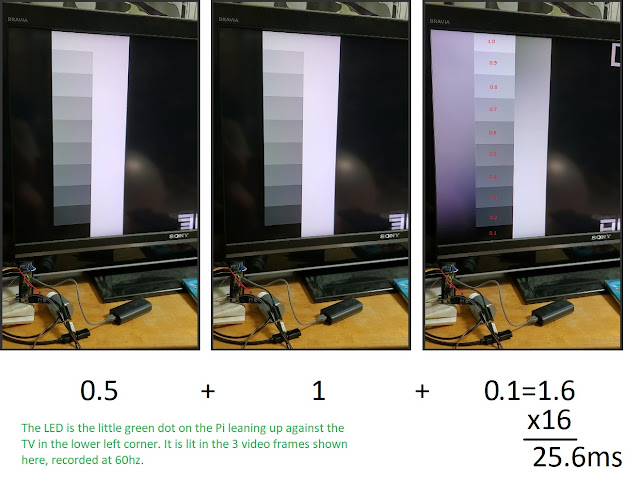piLagTesterPRO input lag test result database
This database shows display input lag and response time (in ms) measured using the pi Input Lag Tester PRO. Since other databases only show input lag it was necessary to start Yet Another DB. Please email me (form below) if you have data to contribute.
Values in red denote average measurements for TVs that have inconsistent lag; between power cycles the lag will vary significantly (typically +/-8ms).
Scan out is how long it takes for the display to draw from the top to the bottom of the screen. You might expect this to be 1/60=16.6ms but some displays draw much faster once they finally get started.
Values in red denote average measurements for TVs that have inconsistent lag; between power cycles the lag will vary significantly (typically +/-8ms).
A quick definition of terms:
Native min lag is the average amount of lag (in ms) between sending the video frame over HDMI and the start of the monitor response at the upper edge of the screen (the threshold for "response" is 5% of a complete response) at the panel's native resolution. IE it does not include response time.
Response time is how long it takes a pixel to go from 0 (black) to 80% of full intensity (perceptually, nearly white).
Native min lag is the average amount of lag (in ms) between sending the video frame over HDMI and the start of the monitor response at the upper edge of the screen (the threshold for "response" is 5% of a complete response) at the panel's native resolution. IE it does not include response time.
Response time is how long it takes a pixel to go from 0 (black) to 80% of full intensity (perceptually, nearly white).
Scan out is how long it takes for the display to draw from the top to the bottom of the screen. You might expect this to be 1/60=16.6ms but some displays draw much faster once they finally get started.
Real Lag is how long it takes for the entire frame of video to be rendered from top to bottom of the screen; it is the sum of the min lag, response time, and scan out.
In addition to the summary stats, full measurements are also included further to the right in the spreadsheet:
top 1st = minimum lag
top full = top 1st + response time
bottom 1st = top 1st + scanout
bottom full = real lag
There are other lag databases, but none that report response time and scan out, or summarize the real lag for each resolution. But, other database's are much larger. I like the one from retroRGB which allows you to submit your own values. To compare between databases you want to use the "top, 1st" value reported here.
In addition to the summary stats, full measurements are also included further to the right in the spreadsheet:
top 1st = minimum lag
top full = top 1st + response time
bottom 1st = top 1st + scanout
bottom full = real lag
There are other lag databases, but none that report response time and scan out, or summarize the real lag for each resolution. But, other database's are much larger. I like the one from retroRGB which allows you to submit your own values. To compare between databases you want to use the "top, 1st" value reported here.



Comments